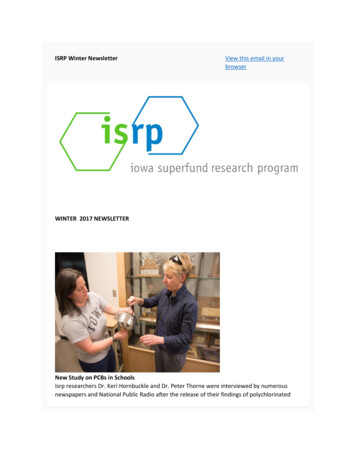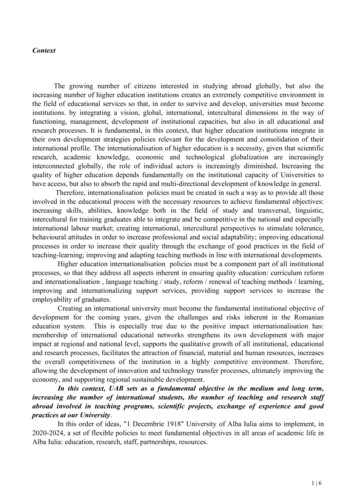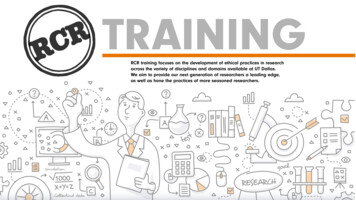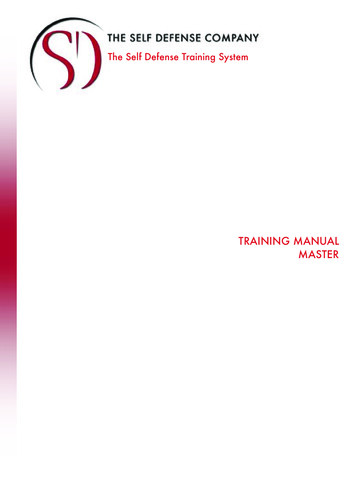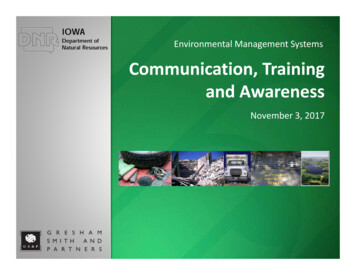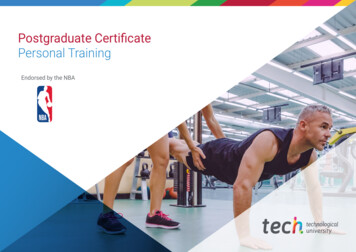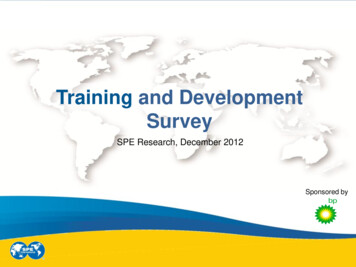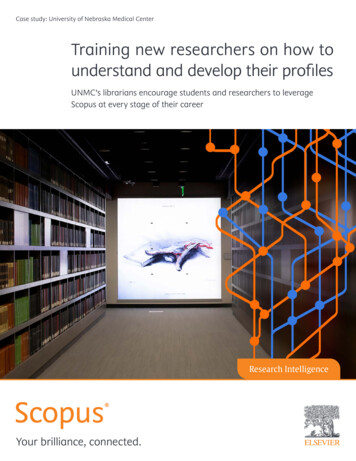
Transcription
Case study: University of Nebraska Medical CenterTraining new researchers on how tounderstand and develop their profilesUNMC’s librarians encourage students and researchers to leverageScopus at every stage of their careerResearch IntelligenceYour brilliance, connected.
“ Scopus really plays a vital role inhelping our researchers, particularlyearly investigators and people who aregetting ready to become early-careerpostgraduates, better understand thescholarly communications landscape.”—Emily Glenn, Associate Dean, UNMC libraryFor researchers, the choices they make and the profilesthey build are critical steps on their road to success.Importantly, their academic standing also contributes tothe reputation of their institution. The Leon S. McGooganHealth Sciences Library at University of Nebraska MedicalCenter (UNMC) has initiatives in place to support theirstakeholders, whatever their age and career stage. But akey strand of their work is educating future postgraduatestudents and emerging researchers on how Scopus canhelp them understand and build their profiles.BackgroundThe mission of the Leon S. McGoogan Health Sciences Library is acompelling one. At its heart lies a drive to connect the past, informthe present and build the future — goals that are evident in theactivities delivered by Emily Glenn, the library’s Associate Dean,and her colleagues in the Education and Research Services team.Together, they serve the information needs of UNMC’s extensivestudent body — UNMC has six colleges, two institutes and agraduate studies program serving more than 4,000 students. Theyalso support a wide array of faculty and staff, as well as Nebraska’slicensed health professionals and state residents. In terms ofresources, the library team manages an extensive collection of rarebooks and history of medicine artifacts, anatomical models, andonline resources numbering more than 36,000 journal titles andover 71,000 print and electronic books.For Emily, one of the aspects of her work that most closely chimeswith the library’s mission, are the education initiatives they deliverfor students and early career researchers. In this case study, sheexplains how Scopus forms the core of those training activities.Your brilliance, connected.
The challengeThe solutionFor those embarking on a PhD or other postgraduate program,there is a wealth of information to absorb; not only do they needto immerse themselves in their chosen topic, there are also bestpractices around studying and evaluating sources to learn, as wellas decisions to make around next steps. If they continue down thepath of academia, that workload often becomes more daunting,with demands ranging from securing funding, collaborators andcareer progression to developing a publication record and profilethat will help them achieve those goals.For Emily, ensuring those starting out on their careers areequipped with the skills to understand and develop their profileis key, and Scopus is one of her go-to resources. “Scopus reallyplays a vital role in helping our researchers, particularly earlyinvestigators and people who are getting ready to becomeearly-career postgraduates, better understand the scholarlycommunications landscape.”The challenges that universities face today are equally pressing.University rankings — several of which rely on Scopus data —are growing in importance, along with collaborations of all types.At the same time, there is a limited pool of students, fundingand talented faculty to draw on. Being able to demonstratethe impact and reputation of researchers and their outputs arecrucial if they want to remain competitive.The university’s Summer Undergraduate Research Program isa great example of how Emily and her team leverage the datain Scopus. Each year, up to 100 undergraduate students joinUNMC’s research teams over the summer break to discover firsthand the spectrum of research activities occurring on campus.For the university, it’s an early opportunity to discover the talentedresearchers of the future. For the students, the laboratoryexperience they gain can prove invaluable when applying tograduate programs at UNMC.According to Emily, an important part of the students’ curriculumis learning about Scopus and other information resources. Sheexplains: “Our hope is that they’re going to enter UNMC and wefeel it’s important to introduce them to the type of tools they willuse in a graduate setting.”3
Discovering the potency of author profilesOne of the key elements of Scopus they explore together arethe 17 million author profiles. These profiles are automaticallygenerated by Scopus, which uses a powerful algorithm to matchauthors to their published papers in the database. The resultingauthor profile page showcases a variety of metrics that are oftenused for tenure, funding and other research performance-baseddecisions. These include: Publishing history Research topics they’ve contributed to Publishing collaborations“I tell people that there are a lot of resources thatorganize professional output, but Scopus is oneof the more robust tools. Other universities useScopus; it’s going to be around for a long time.” Document and citation counts and trends h-index Recent preprints they’ve published“Scopus author profiles spotlight scholarshipconnections and community. The details theycontain raise awareness of publishing trendsand journal sources.”—Emily GlennWhy talk about author profiles tostudents and early career researchers?Emily says: “We want to get them thinking about whothey are in this research space. They are a researcherwith a reputation. Their Scopus author profile is part ofthe trail of their professional presence. It’s one of theplaces that colleagues will consult when they are lookingfor a collaborator.”Your brilliance, connected.“We explain to them that they have an opportunity to make thatprofile shine,” says Emily. “One of the ways they can do that isby aiming for reputable titles that are indexed by databases likeScopus. We talk about what it takes to publish a reputable workthat appears in places where their fellow scholars can find it, readit and share it. And we talk about the importance of building onthe knowledge of others and why they want to be a part of that.Students and researchers walk away understanding that Scopusis a tool that can help them discover and present work thatcolleagues can access.”—Emily GlennUsing profiles to identify career opportunitiesEmily also explains to students the benefits of exploring otherpeople’s Scopus profiles. She says: “I jokingly call it professionalsnooping, but really author profiles are a great way to viewpeople who are experts in their field and identify some of theinfluencers. For example, a student can look at their own UNMCmentor’s profile and track the trajectory of that person’s work.Author profiles can help students become aware of the variousstages of a research-focused career.“Importantly, it gets them to touch the database and becomefamiliar with how it works. We also look at connections to theresearcher profiles in Research Nebraska, our Pure service.”
5
The importance of building a soundknowledge baseFor Emily and the education and research services team, anotherimportant aspect is that the students learn about diversity in theprofession — not only in terms of the variety of researchers andcareer options out there, but the range of works and collaboratorrelationships that comprise scholarly output. “We want them toknow that journal articles aren’t standalone publications: there areauthoritative resources that can provide structure to this vast bodyof knowledge that continues to grow.”“As librarians, we often think all researchinformation should be free. However, research mustbe organized so that it can support reproducibility.That’s really the strength of a resource like Scopus.It’s an authoritative source that allows researchersto build on existing knowledge.”—Emily GlennEvaluating impact: Scopus’ metricsdemonstrate value at every career stageEmily also teaches students how to use citation measures such asScopus’ CiteScore to evaluate the impact of research, authors andpotential collaborators. In addition, she walks them through thePlumX metrics available in Scopus, which move beyond citationsin research articles to capture other references, including: Citations in clinical guidelines and patentsFor Emily and her team, that doesn’t just mean making researchersaware of their own author profile, but also equipping them with theskills to pass that knowledge on to the next generation of researchers.“Together we can ensure that everyone starting out on their careerunderstands the benefits of building the right reputation.”How Emily uses Scopus to train studentsAmong the exercises that Emily asks participants in the summerschool to complete are: Look up your mentor or another UNMC author. What do theirpublications tell you about their career history? Have theymoved institutions? Can you tell which of their papers are themost influential by citations? Where does your mentor publish? Search for papers about your topic, limiting your terms to the titlefield and last five years. Sort by the highest number of citations.Now, remove the date limit. What is the difference in the numberof papers? What do you notice about citation numbers? Select one paper that looks relevant to your research question(with at least five citations). Look at the record for this article.How could you get full text of items in this paper’s references?Look at the “Cited by” box. How could you use this information? Look up a journal. What are the conditions a title must satisfyto be included in Scopus? What does a five-year trend for thisjournal look like? Is this a good journal for you to publish in?Can you compare this journal to another one you know? Usage, such as downloads and views Bookmarks, favorites and saves Online mentions, e.g., in blog posts, news itemsor on social media Look at your list of search results from any search. Let’s practiceexporting them to your reference management software.“It’s really fun to explain that there is this long tail ofimpact and it’s multi-layered. I think the altmetricsoffered by Plum Analytics in Scopus help earlycareer and emerging researchers see that they canbe recognized for credit, influence and reach.”—Emily GlennYour brilliance, connected.But it’s not only students and younger researchers that Emily andher team advise on author identity, as she explains: “We find thatpeople at all career levels can benefit from our advice. Perhapsthey have recently joined UNMC and didn’t receive the same kindof librarian support elsewhere, or perhaps they’ve been workingin another setting with limited access to research resources. Ourgoal is to give them the grounding they need to be successful withtheir peers at UNMC, whatever their level.”
About the universityThe University of Nebraska Medical Center (UNMC) was founded in 1881.Originally the Omaha Medical College, the college became affiliated with theUniversity of Nebraska in 1902. It is Nebraska’s only public academic healthsciences center, committed to educating the state’s future health care workforce.UNMC comprises six colleges — medicine, dentistry, nursing, pharmacy, publichealth and allied health professions — which work together to provide care andsolve societal challenges. For example, it was scientists at UNMC who found thatthe novel coronavirus COVID-19 spreads through airborne transmission. UNMCalso led the first clinical trial in the US on the use of remdesivir to treat patientshospitalized with COVID-19.Located in a handful of Nebraska’s landmark hometowns (Omaha, Lincoln, Kearney,Norfolk and Scottsbluff-Gering), UNMC’s divisions across the state are bondedthrough a shared culture — and in real time, by distance-learning technology.7
Scopus is the largest abstract and citation database and premier sourceof author profiles in the world, offering high quality data and tools foranalyzing the research landscape — so you can advance your research,keep an eye on key and emerging trends, increase research visibility, anddiscover new collaborators.For more information about Scopus,visit elsevier.com/solutions/scopus.Elsevier officesASIA AND AUSTRALIATel: 65 6349 0222JAPANTel: 81 3 5561 5034KOREA AND TAIWANTel: 82 2 6714 3000EUROPE, MIDDLE EAST AND AFRICATel: 31 20 485 3767NORTH AMERICA, CENTRAL AMERICA AND CANADATel: 1 888 615 4500SOUTH AMERICATel: 55 21 3970 9300For a complete list of Elsevier offices,please visit elsevier.com/about/locations.Copyright 2021 Elsevier B.V.March 2021
Together, they serve the information needs of UNMC's extensive student body — UNMC has six colleges, two institutes and a graduate studies program serving more than 4,000 students. They also support a wide array of faculty and staff, as well as Nebraska's licensed health professionals and state residents. In terms of
